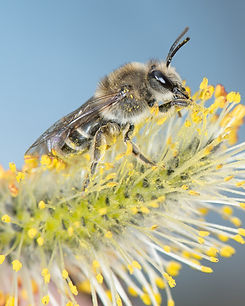
Family Megachilidae > Genus Anthidium
Anthidium
Carder Bees
In Minnesota, there are four described species within the genus Anthidium. Two of these species, Anthidium manicatum and A. oblongatum, are introduced or non-native species and more commonly observed than the native species, A. psoraleae and A. tenuiflorae. A. tenuiflorae was last recorded in Minnesota in 1939. A. psoraleae, a specialist of Psoralea, has only been recorded in three Minnesota counties. The two non-native species are generalists, commonly visiting weedy and invasive plants such as birdsfoot trefoil. These non-native males establish territories near the plants frequented by females looking for pollen, nectar, or nest materials (carded plant hairs). Males defend their territories, often flying into intruders, knocking them off flowers with the spines on the end of their abdomen. Bees in this genus construct solitary nests either in pre-existing cavities aboveground or belowground and line their nests with collected plant hairs.
Females collect pollen on hairs underneath their abdomen. Anthidium are robustly-shaped, have a black or dark gray integument, and large mandibles housing five or more teeth. The non-native species have yellow markings on their head, thorax, and legs; the native species have white or light yellow markings. Bees in this genus are adept at hovering, particularly when near flowers or when males are defending an established territory. Unlike other bees in the tribe Anthidini (Anthidiellum, Dianthidium, and Paranthidium), Anthidium do not have an arolium (a pad between their front tarsal claws). Bees in this genus range in length from 8 to 17 mm (0.3 to 0.7 inches).

Anthidium psoraleae, a native species.

Anthidium manicatum, a non-native species.

wing
position
on flowers

N0. species in MN
4
size range

Phenology

Genus Characteristics

Large mandibles with five or more teeth. No arolium (pad between tarsal claws).
female

Robust form; often hover in front of flowers or when males are defending territories.
male

Dark gray or black integument with yellow or white markings.

female
Females collect pollen on hairs on the underside of their abdomen.
Distribution

Anthidium manicatum

Anthidium oblongatum

Anthidium psoraleae

Anthidium tenuiflorae
Portman et al (2023)
Additional Record
Anthidium Species in Minnesota
Scientific Name | Native | Likely Lecty | Host |
|---|---|---|---|
Anthidium manicatum | No | polylectic | |
Anthidium oblongatum | No | polylectic | |
Anthidium psoraleae | Yes | oligolectic | Psoralea s.l. (Orbexilum, Psoralidium, Pediomelum) (Arduser) |
Anthidium tenuiflorae | Yes | polylectic | Phacelia (Gibbs 2023) |
Source: Minnesota Department of Natural Resources, Minnesota Bee Species List (August 2023).
https://files.dnr.state.mn.us/eco/mcbs/mn-statewide-bee-list.pdf
Nest Materials - Plant Hairs
Bees in the genus Anthidium card or collect plant hairs (trichomes) to line and partition brood cells. These bees are commonly called carder or wool carder bees. Females have large mandibles with numerous teeth that scrape and collect plant hairs as they move across a leaf, plant stem, or flower bud. Once a sizeable ball of hairs is collected under the female, she flies back to her nest clasping the mass of hairs in her mandibles.
Graham et al. (2017) examined the volatile organic compounds (VOCs) released from plants after carding damage and noted that there was an increase in visitation to the damaged plant by Anthidium females. They theorized that the bees were using the VOCs as cues to more readily find plants offering hairs.

Carded hairs and cocoons from an old Anthidium nest.



A non-native Anthidium oblongatum female cards plant hairs from an Artemisia ludoviciana plant to use as a nest lining.
Explore More Megachilidae Genera
Note: Two genera/species on the state list are not included in this guide: Ashmeadiella bucconis (last seen in Minnesota in 1949) and Trachusa zebrata (last seen in Minnesota in 1939). If either of these species is rediscovered in the state, they will be added to the guide at that time.
Explore Bee Families

Apidae
15 genera, 133 species
Bumble bees Bombus
Longhorn bees
Epimelissodes, Eucera, Melissodes
Carpenter bees
Ceratina, Xylocopa
Honey bees Apis
Digger bees Anthophora
Cuckoo bees Brachymelecta, Epeolus, Holcopasites, Nomada, Neolarra, Triepeolus
Squash bees Xenoglossa

2 genera, 39 species
Halictidae
10 genera, 133 species
Metallic green sweat bees
Agapostemon, Augochlora, Augochlorella, Augochloropsis
Large sweat bees
Dieunomia, Nomia
Short-faced bees Dufourea
Sweat bees Halictus
Small sweat bees Lasioglossum
Cuckoo (blood) bees Sphecodes
Megachilidae
14 genera, 86 species
Resin and pebble bees Anthidiellum, Dianthidium, Heriades, Paranthidium
Carder bees Anthidium, Pseudoanthidium
Mock orange bees Chelostoma
Mason bees Osmia, Hoplitis
Leafcutter bees Megachile
Sharp-tailed cuckoo bees Coelioxys
Dark cuckoo bees Stelis

Explore Other Bee Families
Megachilidae
Resin, carder, mason, and leafcutter bees

Citations and Further Reading
Droege, S., et al. (2024). The Very Handy Bee Manual: 2.0. How to Catch and Identify Bees and Manage a Collection.
Gibbs, J., Hanuschuk, E., Miller, R., Dubois, M., Martini, M., Robinson, S., ... & Onuferko, T. M. (2023). A checklist of the bees (Hymenoptera: Apoidea) of Manitoba, Canada. The Canadian Entomologist, 155, e3.
Mitchell, T. B. (1960). Bees of the eastern United States. Technical Bulletin No. 141. North Carolina Agricultural Experiment Station.
Portman, Z. M., Gardner, J., Lane, I. G., Gerjets, N., Petersen, J. D., Ascher, J. S., ... & Cariveau, D. P. (2023). A checklist of the bees (Hymenoptera: Apoidea) of Minnesota. Zootaxa, 5304(1), 1-95.
Wilson, J. S., & Messinger Carril, O. J. (2016). The bees in your backyard: a guide to North America's bees. Princeton University Press.
Page Photography Credits
Heather Holm





















